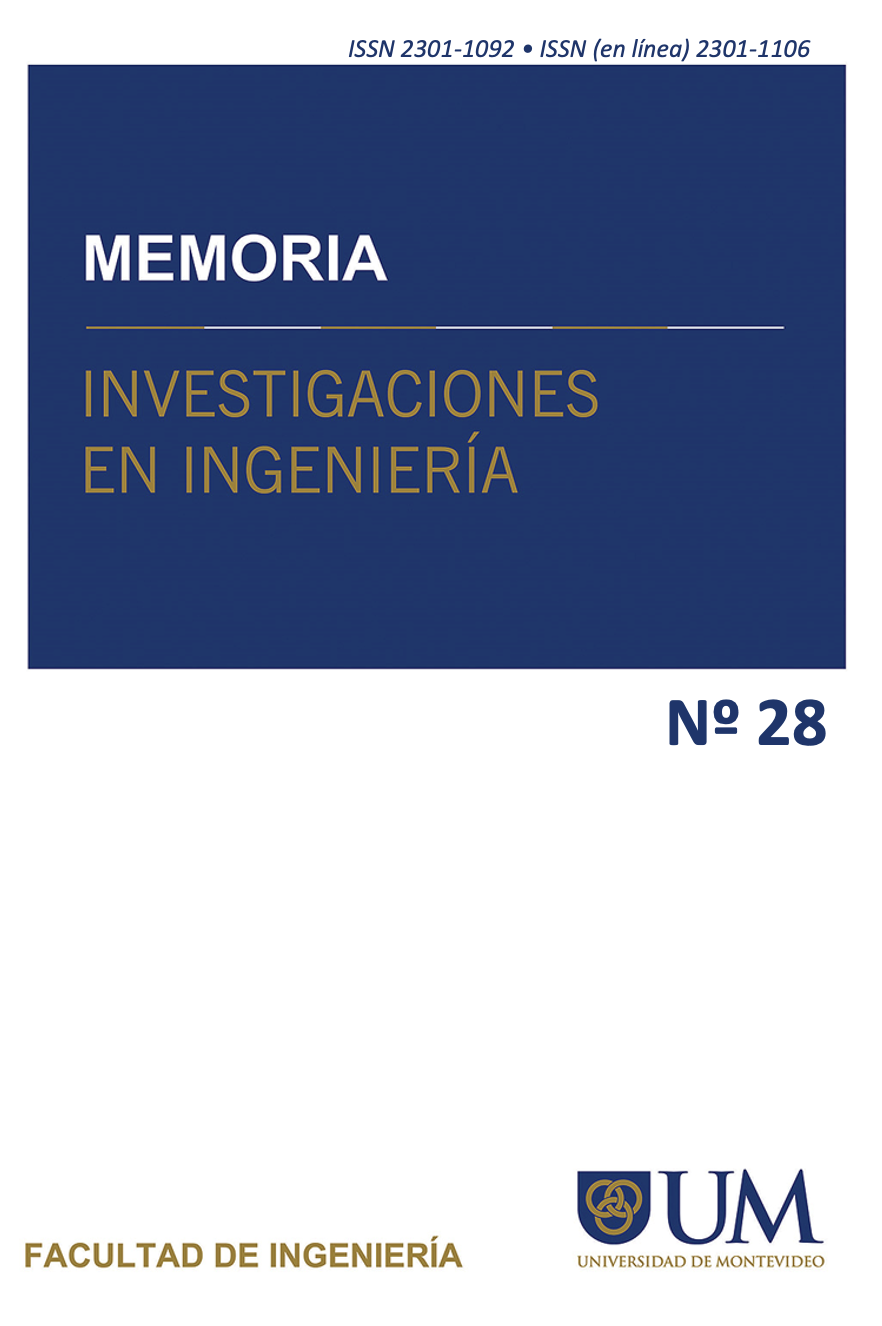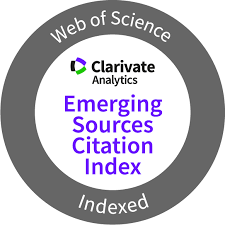Captura direta de carbono no ar usando estruturas metal-orgânicas (MOFs)
desempenho técnico-econômico de sistemas de adsorção por oscilação de temperatura e vácuo (TVSA)
DOI:
https://doi.org/10.36561/ING.28.16Palavras-chave:
Captura direta de carbono no ar, adsorção por oscilação de temperatura e vácuo, estrutura metal-orgânicaResumo
A tecnologia de Captura Direta de Carbono no Ar (DACC) é usada para remover CO₂ diretamente da atmosfera, ajudando a combater as mudanças climáticas e as emissões excessivas de gases de efeito estufa de forma eficiente. Neste estudo, foi realizada uma análise técnico-econômica do DACC, incluindo seus mecanismos de funcionamento, necessidades energéticas e custos, bem como um resumo do status atual da pesquisa. Esta pesquisa compara duas estruturas metal-orgânicas (MOFs) líderes — MIL-101(Cr)-PEI-800 e mmen-Mg₂(dobpdc) — com foco em seu consumo de energia, adsorção de CO₂ e custo. Este estudo investiga o desempenho dessas MOFs em um processo de adsorção por oscilação de temperatura e vácuo (TVSA), que varia ciclicamente a temperatura e a pressão para capturar CO₂ e regenerar adsorventes. Entre todos os materiais, o mmen-Mg₂(dobpdc) atinge o melhor desempenho com uma capacidade muito maior e uma forma isotérmica não linear favorável, indicando eficiência significativamente melhorada e menor consumo de energia. Os sistemas DACC baseados em MOFs avançados são bastante promissores para minimizar as emissões de fontes difusas e, portanto, devem ser considerados componentes essenciais de uma estratégia de mitigação das mudanças climáticas. Este estudo contribui para direcionar futuras pesquisas e desenvolvimentos em direção a MOFs mais eficientes e econômicos em aplicações DACC.
Downloads
Referências
R. A. Kerr, “It’s Official: Humans Are Behind Most of Global Warming,” Science, vol. 291, no. 5504, pp. 566–566, Jan. 2001, doi: 10.1126/science.291.5504.566A.
A. Kaithwas, M. Prasad, A. Kulshreshtha, and S. Verma, “Industrial wastes derived solid adsorbents for CO2 capture: A mini review,” Chem. Eng. Res. Des., vol. 90, no. 10, pp. 1632–1641, Oct. 2012, doi: 10.1016/j.cherd.2012.02.011.
S. A. Montzka, E. J. Dlugokencky, and J. H. Butler, “Non-CO2 greenhouse gases and climate change,” Nature, vol. 476, no. 7358, pp. 43–50, Aug. 2011, doi: 10.1038/nature10322.
R. Checa-Garcia, K. P. Shine, and M. I. Hegglin, “The contribution of greenhouse gases to the recent slowdown in global-mean temperature trends,” Environ. Res. Lett., vol. 11, no. 9, p. 094018, Sep. 2016, doi: 10.1088/1748-9326/11/9/094018.
J. G. Canadell et al., “Contributions to accelerating atmospheric CO 2 growth from economic activity, carbon intensity, and efficiency of natural sinks,” Proc. Natl. Acad. Sci., vol. 104, no. 47, pp. 18866–18870, Nov. 2007, doi: 10.1073/pnas.0702737104.
Y. Wu, J. Xu, K. Mumford, G. W. Stevens, W. Fei, and Y. Wang, “Recent advances in carbon dioxide capture and utilization with amines and ionic liquids,” Green Chem. Eng., vol. 1, no. 1, pp. 16–32, Sep. 2020, doi: 10.1016/j.gce.2020.09.005.
J. Zhang, S. Wang, X. Cheng, C. Chen, L. Zhang, and Z. Wang, “Design strategies and advantages of metal-organic frameworks@ lignocellulose-based composite aerogel for CO2 capture: A review,” Sep. Purif. Technol., vol. 356, p. 129878, Apr. 2025, doi: 10.1016/j.seppur.2024.129878.
A. Sodiq et al., “A review on progress made in direct air capture of CO2,” Environ. Technol. Innov., vol. 29, p. 102991, Feb. 2023, doi: 10.1016/j.eti.2022.102991.
M. Liu et al., “Recent advances and principles of metal–organic framework for the detection of chloramphenicol: Perspectives and challenges,” Microchem. J., vol. 207, p. 111878, Dec. 2024, doi: 10.1016/j.microc.2024.111878.
Y. An et al., “The stability of MOFs in aqueous solutions—research progress and prospects,” Green Chem. Eng., vol. 5, no. 2, pp. 187–204, Jun. 2024, doi: 10.1016/j.gce.2023.07.004.
I. K. Shah, P. Pre, and B. J. Alappat, “Steam Regeneration of Adsorbents: An Experimental and Technical Review,” Chem. Sci. Trans., vol. 2, no. 4, Oct. 2013, doi: 10.7598/cst2013.545.
A. Sinha, L. A. Darunte, C. W. Jones, M. J. Realff, and Y. Kawajiri, “Systems Design and Economic Analysis of Direct Air Capture of CO2 through Temperature Vacuum Swing Adsorption using MIL-101(Cr)-PEI-800 and mmen-Mg2(dobpdc) MOF Adsorbents”.
J. K. Stolaroff, D. W. Keith, and G. V. Lowry, “Carbon dioxide capture from atmospheric air using sodium hydroxide spray: Supporting Information”.
“Sodium Hydroxide-Based CO2 Direct Air Capture for Soda Ash Production─Fundamentals for Process Engineering | Industrial & Engineering Chemistry Research.” Accessed: Sep. 25, 2024. [Online]. Available: https://pubs.acs.org/doi/10.1021/acs.iecr.3c00357
K. Heidel, D. Keith, A. Singh, and G. Holmes, “Process design and costing of an air-contactor for air-capture,” Energy Procedia, vol. 4, pp. 2861–2868, Jan. 2011, doi: 10.1016/j.egypro.2011.02.192.
P. Tabarzadi and A. Ghaemi, “Modeling and optimization of CO2 capture in spray columns via artificial neural networks and response surface methodology,” Case Stud. Chem. Environ. Eng., vol. 10, p. 100783, Dec. 2024, doi: 10.1016/j.cscee.2024.100783.
M. Mahmoudkhani and D. W. Keith, “Low-energy sodium hydroxide recovery for CO2 capture from atmospheric air—Thermodynamic analysis,” Int. J. Greenh. Gas Control, vol. 3, no. 4, pp. 376–384, Jul. 2009, doi: 10.1016/j.ijggc.2009.02.003.
W. R. Lee et al., “Exceptional CO 2 working capacity in a heterodiamine-grafted metal–organic framework,” Chem. Sci., vol. 6, no. 7, pp. 3697–3705, 2015, doi: 10.1039/C5SC01191D.
L. A. Darunte, K. S. Walton, D. S. Sholl, and C. W. Jones, “CO2 capture via adsorption in amine-functionalized sorbents,” Curr. Opin. Chem. Eng., vol. 12, pp. 82–90, May 2016, doi: 10.1016/j.coche.2016.03.002.
D. Wu et al., “Thermodynamic complexity of carbon capture in alkylamine-functionalized metal–organic frameworks,” J. Mater. Chem. A, vol. 3, no. 8, pp. 4248–4254, Feb. 2015, doi: 10.1039/C4TA06496H.
Z. Yuan, M. R. Eden, and R. Gani, “Toward the Development and Deployment of Large-Scale Carbon Dioxide Capture and Conversion Processes,” Ind. Eng. Chem. Res., vol. 55, no. 12, pp. 3383–3419, Mar. 2016, doi: 10.1021/acs.iecr.5b03277.
“Maximum and Comparative Efficiency Calculations for Integrated Capture and Electrochemical Conversion of CO2 | ACS Energy Letters.” Accessed: Sep. 24, 2024. [Online]. Available: https://pubs.acs.org/doi/10.1021/acsenergylett.3c02489
L. Joss, M. Hefti, Z. Bjelobrk, and M. Mazzotti, “On the Potential of Phase-change Adsorbents for CO2 Capture by Temperature Swing Adsorption,” Energy Procedia, vol. 114, pp. 2271–2278, Jul. 2017, doi: 10.1016/j.egypro.2017.03.1375.
A. Ntiamoah, J. Ling, P. Xiao, P. A. Webley, and Y. Zhai, “CO2 Capture by Temperature Swing Adsorption: Use of Hot CO2-Rich Gas for Regeneration,” Ind. Eng. Chem. Res., vol. 55, no. 3, pp. 703–713, Jan. 2016, doi: 10.1021/acs.iecr.5b01384.
E. S. Sanz-Pérez, C. R. Murdock, S. A. Didas, and C. W. Jones, “Direct Capture of CO 2 from Ambient Air,” Chem. Rev., vol. 116, no. 19, pp. 11840–11876, Oct. 2016, doi: 10.1021/acs.chemrev.6b00173.
J. A. Mason, K. Sumida, Z. R. Herm, R. Krishna, and Jeffrey. R. Long, “Evaluating metal–organic frameworks for post-combustion carbon dioxide capture via temperature swing adsorption,” Energy Environ. Sci., vol. 4, no. 8, p. 3030, 2011, doi: 10.1039/c1ee01720a.
“Electrochemical Approaches for CO2 Conversion to Chemicals: A Journey toward Practical Applications | Accounts of Chemical Research.” Accessed: Sep. 25, 2024. [Online]. Available: https://pubs.acs.org/doi/10.1021/acs.accounts.1c00674
“Techno-economic Analysis of Metal–Organic Frameworks for Hydrogen and Natural Gas Storage | Energy & Fuels.” Accessed: Sep. 24, 2024. [Online]. Available: https://pubs.acs.org/doi/10.1021/acs.energyfuels.6b02510
T. Ahmed, “Chapter 3 - Natural Gas Properties,” in Equations of State and PVT Analysis (Second Edition), T. Ahmed, Ed., Boston: Gulf Professional Publishing, 2016, pp. 189–238. doi: 10.1016/B978-0-12-801570-4.00003-9.
M. S. Shafeeyan, W. M. A. Wan Daud, and A. Shamiri, “A review of mathematical modeling of fixed-bed columns for carbon dioxide adsorption,” Chem. Eng. Res. Des., vol. 92, no. 5, pp. 961–988, May 2014, doi: 10.1016/j.cherd.2013.08.018.
J. L. Plawsky, M. Ojha, A. Chatterjee, and P. Wayner, “Review of the effects of surface topography, surface chemistry, and fluid physics on evaporation at the contact line,” Chem. Eng. Commun., vol. 196, pp. 658–696, May 2009, doi: 10.1080/00986440802569679.
“Water and Metal–Organic Frameworks: From Interaction toward Utilization | Chemical Reviews.” Accessed: Sep. 25, 2024. [Online]. Available: https://pubs.acs.org/doi/10.1021/acs.chemrev.9b00746
“CO2 capture materials: a review of current trends and future challenges - ScienceDirect.” Accessed: Sep. 25, 2024. [Online]. Available: https://www.sciencedirect.com/science/article/pii/S2589234723001690
J. L. Woodliffe et al., “Continuous flow synthesis of MOF UTSA-16(Zn), mixed-metal and magnetic composites for CO2 capture – toward scalable manufacture,” J. Environ. Chem. Eng., vol. 12, no. 6, p. 114167, Dec. 2024, doi: 10.1016/j.jece.2024.114167.
M. Kong et al., “A review on development of post-combustion CO2 capture technologies: Performance of carbon-based, zeolites and MOFs adsorbents,” Fuel, vol. 371, p. 132103, Sep. 2024, doi: 10.1016/j.fuel.2024.132103.
Z. Deng and L. Sarkisov, “Multi-Scale Computational Design of Metal–Organic Frameworks for Carbon Capture Using Machine Learning and Multi-Objective Optimization,” Chem. Mater., vol. 36, no. 19, pp. 9806–9821, Oct. 2024, doi: 10.1021/acs.chemmater.4c01969.
Publicado
Como Citar
Edição
Seção
Licença

Este trabalho está licenciado sob uma licença Creative Commons Attribution 4.0 International License.






















